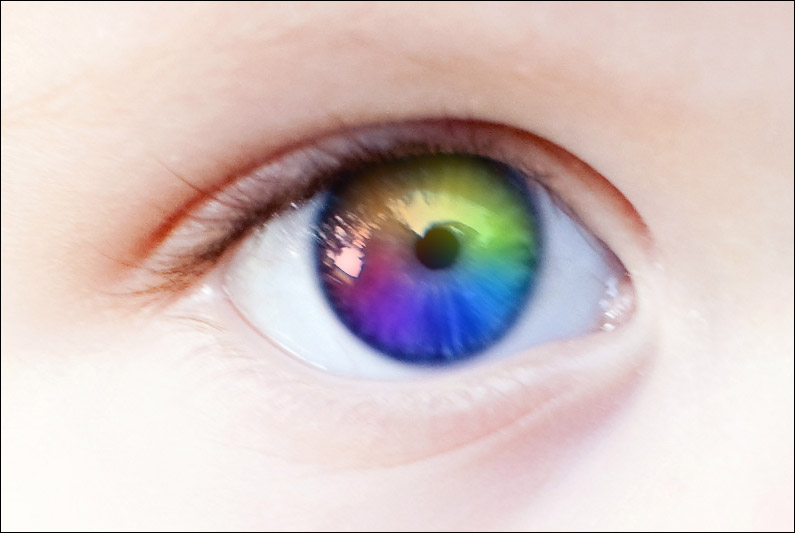<< Learning Center
Media Accessibility Information, Guidelines and Research
Why Describe Color in Video Description?
By Joyce Adams
In the decade that I have worked as a video describer, the most common question I have received from people who are first learning of this mysterious service that provides description of video for people who are blind or have low vision is this:
Why do you describe color?

This question is invariably followed by one or more erroneous, albeit innocent, statements: "A blind person has never seen color." "A blind person doesn't know what color is." And in the words of one producer offering up his program for video description for the first time: "Color is meaningless to people who are blind."
As any seasoned video describer knows, these statements could not be further from the truth. Color does have meaning to people who are blind, and the inclusion of color in video descriptions is more than appropriate—it is necessary. To explain, I would like to address the three myths listed above:
A blind person has never seen color.
According to recent statistics, an estimated 25.2 million adult Americans are blind. Within this group, people who have been diagnosed with legal blindness—central visual acuity of 20/200 or less in the better eye with the best possible correction and/or a visual field of 20 degrees or less—often have some usable (low or restricted) vision and, therefore, some ability to see color, if only certain bright colors or the contrast between various colors. This population also includes people who may have enjoyed full vision at one time—people who have lost their sight due to a disease or accident. Further statistics reveal that nearly 23% of Americans 75 years of age and older report some degree of vision loss and that at least 200,000 Americans develop neovascular age-related macular degeneration each year.
A blind person doesn't know what color is.
Like sighted people, those who are totally blind learn about color in many ways—in the classroom, through the context of everyday conversation, through reading and through experiencing other media including television, radio, and films. In other words, references to color appear everywhere in our daily experiences and daily language. One does not have to see color with his or her eyes in order to know what color is.
Color is meaningless to people who are blind.
Color often possesses intrinsic or symbolic meaning. What person—whether sighted or non-sighted—would not understand the differing meanings of "a bright blue sky" versus "a sky filled with dark gray clouds"? "A woman wearing a long white dress" versus "a woman dressed in all black"? "A gray-haired man" versus "a woman with dark brown hair"?
Even standing alone without further context as explanation, these sample video descriptions offer clear "mental pictures" or "clues," if you will, of what visual image is appearing or of the general ambience of a scene—a sunny day, an overcast day, a bride, a mourner, an older man, a younger woman.

Julia Hales, a bright sixth-grader living in Virginia, has congenital achromatopsia and cannot see colors, nor can she see clearly for more than a few feet. And yet she feels it is "helpful" to hear colors described as part of video description.
"If I hear a description of a girl having dark hair and dark skin, I can form an image of the girl in my mind and project that image into the movie or TV show," Julia explains. Stuart Hales, Julia's father, offers further insight into how describing color benefits his visually impaired daughter: "For Julia's purposes, the advantage to describing colors would be to differentiate objects and scenes from each other. I still remember a day when we were biking…and came upon some deer. The deer were brown; the bushes and trees behind them were green. Julia couldn't distinguish the deer from the bushes because they were of a similar contrast. It wasn't until the deer moved that she noticed them. So explaining that brown deer were grazing next to a stand of green bushes would help Julia understand that the deer and bushes are of different colors, even though she can't see the colors."
Hales explains that when colors of various objects appear in only one shade each, Julia is able to "see" these colors better because the contrasts between them are fixed and therefore easy to commit to memory." Memory plays a significant role in how people with visual impairments such as Julia's "process" color. "Saying something is green means that it's the same color as grass," Hales adds.

The fact that most visually impaired people have learned what color an object usually is makes it all the more important to describe color in video description. A viewer would want to know if something appearing in a video strays from the norm, e.g. the grass is brown, not green, or if a woman's hair is "lavender, or a pale shade of purple."
And this brings me to one additional benefit of describing color in video description—and indeed the benefit of video description in general—and that is to help build the vocabulary of the young viewer. It is our hope at the National Captioning Institute that all viewers—whether blind or sighted, child or adult—learn something new from such descriptions as "Telly, a fuchsia, or pinkish-purple, puppet" and "a tube of cyan, or greenish-blue, paint."
About the Author
Following a brief career as a newspaper reporter and editor, Joyce Adams began her work in the field of accessibility in 1983 as a closed captioner for the Virginia-based National Captioning Institute (NCI). In 2002, she joined NCI's newly established Described Media Department and became the department's supervisor the following year. Ms. Adams is also a published poet. Her work appears in the current issue of The Northern Virginia Review.
Tags:
Please take a moment to rate this Learning Center resource by answering three short questions.
